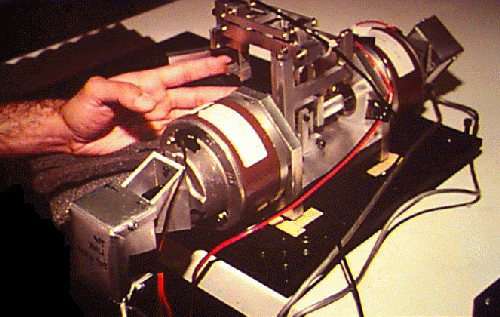
A 2-DOF robot designed by Dr. Howe of the Harvard group was modified
to serve as a "Tactile Stimulator" capable of delivering static and dynamic
stimuli to the human fingerpad (Gulati, 1995; Gulati and Srinivasan, 1995).
Three types of indentors (point, flat circular, and a flat plate) attached
to the stimulator imposed a variety of constant velocity ramps (1 to 32
mm/s), depths of indentation (0.5 to 3mm), and sinusoids (0.25 mm to 0.5
mm amplitude; 0.125 to 16 Hz frequency) under displacement control (resolution
~ 20 microns). The resulting normal and shear forces were measured by
a 2-axis force sensor (resolution ~ 10 mN). The results showed a pronounced
nonlinear force-indentation depth relationship under both static and dynamic
conditions, viscoelastic effects of force relaxation under constant depth
of indentation, and hysteresis under sinusoidal displacements. There was
wide variability in the magnitude of response for the five subjects who
were tested, and their fingertip diameter or volume did not account for
the observed variability. A piecewise linear, lumped parameter model with
spring and dashpot elements was developed to identify the mechanical parameters
causing the nonlinear response. The model predictions with only one set
of parameters for each subject matched the empirical data well under a
wide variety of stimuli. The model represents a compact description of
the data and will be used to verify and tune our finite element models
of the fingertip.
Force response of the human fingerpad to shear
displacement
The 2-DOF Tactile Stimulator was also used to deliver shear displacement
ramp (0.5 to 16 mm/sec for a total shear displacement of 7mm) at various
depths of indentation of the fingerpad (0.5 to 3 mm) by a flat, smooth
Aluminum plate (Towles and Srinivasan, 1994). Only one subject has been
tested so far under these stimuli, and the resulting data has been analyzed
with a view towards fine tuning the experimental protocol and parameters.
The results show that at each depth of indentation, the shear displacement
initially caused increasing skin stretch and shear force, followed by
slipping of the plate across the skin surface. The shear force-shear displacement
was almost linear and slip occurred at around 3mm shear displacement at
all velocities. Low velocities tended to cause stick-slip (as indicated
by oscillatory shear force during slip), whereas the shear force decreased
smoothly at higher velocities. At increasing depths of indentation, slip
occurred at larger shear displacements, as is to be expected. The coefficient
of static friction was obtained by measuring the slope of the normal and
shear forces at the incipience of slip for a given shear velocity. To
a first approximation it was found to be independent of shear velocity.
More experiments on different subjects are being initiated.
|
Click on the following links to read more in specific areas.
|
|


